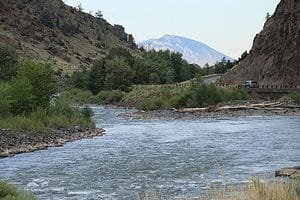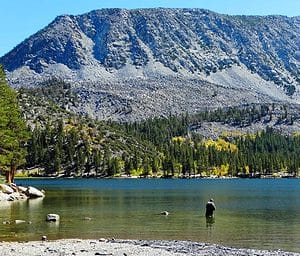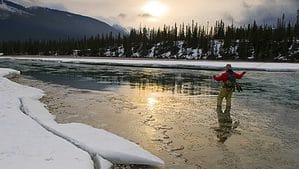Disclosure: Some posts contain affiliate links, which earn us a commission if you make a purchase through them. Positive Fishing © participates in various affiliate networks including the Amazon Services LLC Associates Program.
A week off from work and the opportunity to spend it all in the mountains in search of high-elevation trout is something many of us can only dream of happening.
Minimal pressure on the fish, beautiful scenery and wildlife, and some peace and quiet can create quite a bit of excitement in any angler.
While this idea is enticing, these trips don’t always work out as well as we would hope. The challenging hikes and inclement weather can put a damper on these trips.
Worst of all, however, you may find fish unwilling to take your bait. These situations are frustrating. You feel as if you have everything on your side, but you can’t seem to find any fish who want what you are giving them.
In this article, I will cover the following:
- What are Alpine Lakes, and Where do I find them?
- What Fish Can You Catch In Alpine Lakes?
- Best Tips for Fishing Alpine Lakes
- What Gear is Needed to Fish Alpine Lakes?
What Are Alpine Lakes, And Where Do I Find Them?
Alpine Lakes are categorized as lakes sitting above 10,000 feet in elevation. These lakes are right above the tree line, so it takes extra work from people trying to access them. They’re fully exposed, and almost all of the fish in these lakes are stocked.
Due to the elevation, fish are stocked by vehicles or even by planes. The fish in these lakes are almost always trout! Trout are one of the few species that can survive in these freezing temperatures and be okay with the lack of food that’s often available.
Mountain ranges throughout the Western United States and Canada are filled with these alpine lakes. Again, they’re not easy to access, but the views and potential fish are well worth the effort.
What Fish Can You Catch In Alpine Lakes?
Most fishermen go to the lakes to catch alpine trout. Most species of trout can be found, including cutthroat, golden, and rainbow trout.
Specific trout, such as coastal cutthroat and Westslope cutthroat, are more regional, based on what gets stocked during the summer months.
Arctic graylings are also quite common and are superb and beautiful-looking fish.
9 Best Tips For Fishing Alpine Lakes
Alpine lake fishing is a blast and sometimes referred to as high-mountain fishing!
The experience is fantastic, and you’ll find opportunities you wouldn’t find anywhere else in the world. Regardless of your success, take advantage of the opportunity to explore these areas.
Accept Where You Are
Anglers have to head into an alpine lake fishing trip with different expectations than they usually would. It’s not a casual trip out on your bass boat!
You have to deal with weather, animals, and challenging terrain. At any point, you must be willing to change your technique or your bait in case something isn’t working.
You’ll have days spoiled by the weather and everything else in between. Changes in temperatures, pressure systems, and precipitation can cause fish not to want to feed or entirely change their feeding patterns, and you have to figure out what they want.
Take More Flies And Lures Than Usual
When anglers think about alpine lakes, they imagine fish that haven’t ever seen an artificial lure that would be willing to eat just about everything that is thrown in front of them. While this is sometimes the case, it’s rare. More often than not, you’ll have to experiment with various tackle.
If you’re fly fishing, make sure you have nymphs, streamers, and a variety of dry flies. You may have to try every single one of them before you have the chance to land something.
Bring lures, jigs, and even some soft plastics if you’re spin fishing. You never know what the fish are going to want! They may chase after the most basic or complicated lure you have.
Fish All Levels Of The Water Column
While fish in alpine lakes often do hit on the surface, don’t underestimate any part of the lake. Depending on the time of year and outside temperatures, they’ll be in various places. When it’s been warm, and you’re in the heat of the summer, fish will be in the deeper water to ensure they’re comfortable.
As the ice moves off the lake in the spring and early summer, the fish will be in the shallow water and be extremely aggressive.
At the end of the day, don’t force your way into the water to fish. Fish where it’s safe and available to you, and see if you can find any fish. If you don’t see rises, do your best to go deeper. Most trout will feed on the surface when the insects begin to hatch in the mornings and evenings.
Find Moving Water

Many high-elevation lakes have creeks either running in or out of them. You may even find two or three lakes right near one another. If possible, fish near the water that connects all of these lakes.
Fish, especially trout, love these oxygenated waters. These creeks mean food and more oxygen. Find where creeks flow into the lake and start here. You have a great chance to find fish.
Stealth Truly Does Matter
Every angler remembers when they were learning to fish and got caught being loud or moving around too much. Whether it was your dad or friend, we all have been yelled at for being too active and potentially spooking fish.
While everyone has their own opinion about whether or not it’s important to be quiet, it truly does matter on alpine lakes.
Fish can identify when something is off. Your large shadow or kicking a rock into the water can cause a fish to leave that area and not come back for a long while.
Whether you’re climbing over rock falls or trying to access a specific area, do your best to stay quiet and keep your shadows away from the prime water. The trout will see you and gladly ruin your chances of catching them. It’s even smart to be stealthy as you approach the lake.
Lead Your Fish
If you’re fly fishing or throwing any sort of topwater lure, watch for the feeding patterns of the trout. As they begin to feed on the surface, fish will often feed in somewhat of a line.
Thankfully, most alpine lakes are extremely clear, and you can see how fish like to feed. Once you identify the direction the fish are feeding, you can make your casts.
You always want to lead your fish. In the extremely clear water that you’ll fish on alpine lakes, it’s not a bad idea to lead your fish a bit more than you normally would. Lead them by four or five feet. Your fly and line hitting the water won’t necessarily spook the fish, and it’s long enough for them to continue in their pattern and take your bait without thinking twice.
Explore!
The best thing about fishing these lakes is that you can explore! You’re likely close to alone and in a beautiful location.
Take along a map and see what other sorts of lakes are nearby. They may be smaller or much bigger. It will likely take some climbing and scrambling, but it may be well worth your time!
Follow moving water. Odds are, you’ll run into some more lakes. Also, another thing to do is look at the base of mountain peaks. There are likely large bowls at the base of these peaks where rocks fall and snow melts.
Use Google Maps
I strongly suggest that you take the opportunity to get familiar with google maps. Finding remote alpine lakes is so much easier today than ever before. Also, you can pinpoint good potential road access and the terrain and lake topography.
The great thing about using google maps is that you can research this before you go. This saves a lot of time and can definitely improve your catch rate.
To understand more about fishing with google maps, please take a look at my article here!
Look At Alpine Lake Stocking Reports
If you want to know what lakes contain stocked trout, take a look at the state’s stocking reports. You’ll learn when the lakes were stocked, what fish were put in them, and you might even learn how many were stocked.
This will help you know where to fish and what lakes to avoid. Yes, it’s possible that a population of fish is naturally in a lake that wasn’t stocked, but that’s rarely the case.
What Gear Is Needed To Fish Alpine Lakes?

Knowing what gear to take to alpine lakes requires research and trial and error. Once you do your first trip, you’ll learn what type of gear works for you.
Rods
Most alpine fish will not be huge, so lighter rods will work fine.
If you’re fly fishing, a four or five-weight rod with a length of 8 or 9 feet is plenty. You’ll have the length to make longer casts and fight any fish that may be a bit oversized. If you’re spin fishing, a light 6’3” setup is plenty.
Remember, you will have to carry whatever you bring with you!
Reel
You don’t need heavy reels when going to alpine lake fishing. I suggest taking one spinning reel of 3000 size and also a standard fly reel.
If you own a rod and reel combo set, then take this along. Keep it simple, but give yourself the options for both spinning and fly fishing.
Line
Line and tackle are your two most important pieces of gear for alpine lake fishing. Whether you’re spin fishing or fly fishing, you want your line to be clear and thin. You’re not going to tie into massive fish, so you don’t need a heavy test.
If you’re fly fishing, take alone 4 to 6x tippet. This is thin enough for you not to spook any fish you find. Bring along two to four-pound monofilament if you’re spin fishing. It’ll keep you hidden and only have the fish focus on your bait.
If the fish are spooky, you may have to consider using a fluorocarbon line. The Low visibility of the fluorocarbon line makes it nearly invisible underwater. This can be a huge factor in the alpine clear water and when targeting skittish fish.
Tackle
Bring the tackle you would normally use to target trout, but bring even more! You want plenty of tackle because you know it is a long walk to get back to your car to reload on any flies or lures you may have forgotten.
Wearing a fishing vest makes fishing much simpler in the alpine lakes. A vest can easily carry your forceps, fly floatant, extra tippet spools, scissors, and basic fly boxes. Having everything at hand will make fishing a more enjoyable experience.
Tip: Always ensure you carry a multi-purpose pocket knife; they can be a godsend at certain times.
For fly anglers, Parachute Adams and Elk Hair Caddis are great dry flies to bring along. Woolly Buggers, Prince Nymphs, and even Pheasant Tail patterns will provide you with success.
For spin anglers, don’t forget about Rooster Tails, Panther Martin’s, and Spoons. These work at lower elevations, and they work great at higher elevations. Take a variety of colors! You never know what they’re going to want to eat.
Backpack
Walking long distances can be tough on the legs and back. So make sure you have a backpack carrying all your fishing gear and basic necessities. A comfortable backpack is key to enjoying several hours away from the car or the lodge that you stay in.
If you plan to be out for several hours, ensure you carry some food and water.
Clothing

Alpine lakes being high up, get changeable weather, so make sure you take a waterproof jacket and trousers. You can leave a change of clothes back at the lodge or in your car.
Footwear
Be prepared to walk quite a bit. I suggest taking some hiking boots to wear from your car, and if needed, you can put on a pair of rubber sandals when you start fishing. These allow you to wade into the water if necessary, giving you a much better chance to find the fish.
Waders
While waders are great to use in cold water, walking or carrying them is not a particularly enjoyable task.
This is a personal choice based on the individual. If you are not walking too far from the car, then this probably is a good option to take them. If you don’t expect to spend too much time in the water and it’s not too deep, then I would just leave them in the car.
Weighing up the possibility of getting better access to catch more fish versus the hassle is best decided on the day by the individual and where you plan to fish.
What Is A Wilderness Permit?
Wilderness (or backcountry) permits regulate the amount of foot traffic in fragile environments that can only handle so much use before they begin to erode.
Limiting the number of visitors to these areas preserves the environment and enhances visitors’ experience. This allows you to fish in peace and quiet with nature.
Some wilderness permits are free, and others have a small fee. Take note that some are seasonal, and others are required year-round. You can find out more about passes on the National Park Service website.
Safety And Etiquette When Fishing Alpine Lakes
Always follow the rules in the lakes you are fishing in. Catch and release methods are recommended by most states.
Always remember to inform people where you’re planning to go and ensure you always stay safe.
Lastly, always ensure you take back everything, including any garbage, line, or food items. Let’s keep the area super clean and respect nature to its fullest!
Final Thoughts
Alpine lake fishing in the mountains is a great experience. The fishing tends to be pretty simple, so don’t overthink it.
Remember, these fish have a very short growing season, so they tend to be pretty aggressive and active feeders. This makes for a very exciting experience for all anglers.
I hope this article was interesting and makes you want to go out and do some Alpine fishing. You can read more on my other articles on Fly Fishing Fast-Moving Rivers and Spin Fishing Fast-Moving Rivers – Just follow the links!
- Wading Belt Essentials: Ensuring Safer Fishing - January 9, 2024
- Fishing For Catfish (Top Tips, Bait, & Gear To Catch The Big 3) - October 20, 2022
- Fishing Line Strength Vs. Diameter Chart: Why Is It Important? - October 12, 2022

